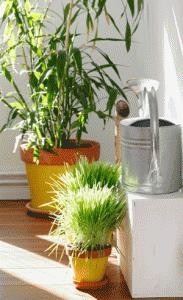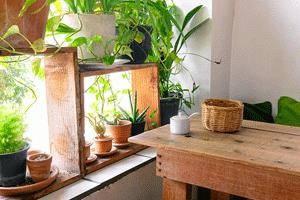Watering Houseplants: Tricks and Tips
 All houseplants need water, to varying degrees of course. No matter what you grow indoors, we’ve got the ins and outs of watering houseplants for the best results.
All houseplants need water, to varying degrees of course. No matter what you grow indoors, we’ve got the ins and outs of watering houseplants for the best results.
When to water:
- There are exceptions to every rule, but for the most part houseplants should be watered when the top inch or so of potting mix feels dry to the touch. As you get to know your houseplants, you’ll eventually know when they need water by the weight of the pot. If it “feels light,” chances are it’s time to water.
- Plants may need less water in winter, when they’re less actively growing. As light levels and warmth increases in spring, watch for signs of new growth. As the plant draws more water from its soil mix to fuel growth, you may find the soil dries quicker and more frequent watering is needed.
- Small pots dry out quicker than large pots, so keep a close eye on these.
How to water:
- With most plants, you can simply pour the water directly into the potting mix until it begins to run out through the pot’s drainage holes. Let the pot drain for a while and then place it back where it belongs. If you use a saucer, or the pot has a connected saucer, check to see if there’s water in it after about a half hour. If there is, damp that water out.
- Some houseplants do not like water collecting in their crowns—where their stems or leaves meet the soil. These include African violets, cape primroses and certain begonias. Water these houseplants from below; sit their pot in a container of water so that the potting mix draws water up from the pot’s drainage holes (or through the sides of the pot if it is porous clay). When the soil surface looks damp, remove the pot from the water and let it drain.
- Plants that are watered from below should occasionally be carefully watered from above to flush salts out of the potting mix.
- If you’ve neglected to water your plant for so long that the soil has dried and pulled away from the sides of the pot, sink the pot in a bucket of water until the potting mix loosens and expands again (provided that the plant is still alive.)
Water preparation:
- Use room-temperature water to avoid shocking the plant.
- There is no need to let water sit overnight before using it on plants. This has been recommended as a way to let chlorine evaporate, but there generally isn’t enough chlorine in tap water to harm most plants.
- If you have soft water, you can use it to water your houseplants, but be sure to flush the salts that can accumulate in the potting mix once a month or so. Simply pour water into the pot until it runs out the bottom; wait for it to drain completely and then repeat the process.
 Increase Humidity for Houseplants
Increase Humidity for Houseplants
Houseplant books and hang tags often mention that indoor plants appreciate humidity. The typical home doesn’t always offer moist air, though, especially in winter, when the air is naturally more dry and most heating systems dry it even further.
Some recommend misting the air around houseplants with a spray bottle as a way to increase humidity. The effect doesn’t last very long after you stop misting. Here are easier, more effective ways to increase humidity around your houseplants:
- Fill the saucer underneath the pot with pea gravel or aquarium gravel. Add water to the saucer so that the gravel is damp. Place the pot on top of the gravel. The water will slowly evaporate, adding moisture to the air immediately around the plant. The gravel is necessary because it elevates the pot, preventing the soil from wicking up the moisture and defeating the purpose (besides creating soil conditions that are potentially too damp for the plant). As the water evaporates you’ll need to top it off, so check its level each time you water the plant.
- Make a humid microclimate by clustering groups of houseplants together. They can be in individual pots or you can create large dish gardens of several plants (just make sure they appreciate the same soil conditions and have a similar rate of growth). Cluster the plants together will increase humidity thanks to their transpiration and the moisture released by their soil surfaces and gravel trays.
- Use glass cloches or large glass jars to increase humidity around single plants. Simply place the cloche (or the jar, upside down) over the plant and its pot. This serves as a mini greenhouse, trapping moisture inside. Be sure to take the cloche or jar off a couple of times a week to let fresh air in.
- Place potted plants inside an empty fishtank, with or without a lid. Again, the sides of the tank will trap moisture that’s released from the plants leaves and soil. (If you’re more ambitious, you can of course take the extra step of planting the fishtank as a terrarium.)
- Keep your houseplants in a room that’s naturally more humid than others, such as the bathroom or kitchen. The plants will appreciate the steam from the shower, tub, dishwasher, kitchen sink, tea kettle, pasta water and so on. If you run a humidifier in any room for health reasons, that would of course be a good placement for humidity-loving plants, too. Just make sure that the room you choose also provides adequate light.